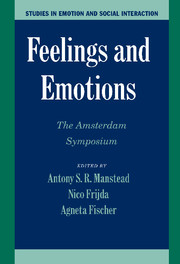Book contents
- Frontmatter
- Contents
- List of Contributors
- 1 Introduction
- PART I THE NATURE OF FEELINGS AND EMOTIONS
- 2 On the Passivity of the Passions
- 3 Emotions and Rationality
- 4 Emotions and Feelings
- 5 The Concept of an Evolved Fear Module and Cognitive Theories of Anxiety
- 6 Deconstructing the Emotions for the Sake of Comparative Research
- 7 From the Emotions of Conversation to the Passions of Fiction
- PART II BASIC PSYCHOLOGICAL PROCESSES IN FEELINGS AND EMOTIONS
- PART III FEELINGS AND EMOTIONS: THE PLACE OF PLEASURE
- PART IV FEELINGS AND EMOTIONS IN THEIR SOCIOCULTURAL CONTEXT
- PART V FEELINGS, EMOTIONS, AND MORALITY
- Subject Index
- Author Index
- Plate section
- References
5 - The Concept of an Evolved Fear Module and Cognitive Theories of Anxiety
Published online by Cambridge University Press: 05 June 2012
- Frontmatter
- Contents
- List of Contributors
- 1 Introduction
- PART I THE NATURE OF FEELINGS AND EMOTIONS
- 2 On the Passivity of the Passions
- 3 Emotions and Rationality
- 4 Emotions and Feelings
- 5 The Concept of an Evolved Fear Module and Cognitive Theories of Anxiety
- 6 Deconstructing the Emotions for the Sake of Comparative Research
- 7 From the Emotions of Conversation to the Passions of Fiction
- PART II BASIC PSYCHOLOGICAL PROCESSES IN FEELINGS AND EMOTIONS
- PART III FEELINGS AND EMOTIONS: THE PLACE OF PLEASURE
- PART IV FEELINGS AND EMOTIONS IN THEIR SOCIOCULTURAL CONTEXT
- PART V FEELINGS, EMOTIONS, AND MORALITY
- Subject Index
- Author Index
- Plate section
- References
Summary
ABSTRACT
Consistent with theories that postulate appraisal as a key mechanism of emotion, the theoretical rationale behind the currently prominent cognitive therapy for disorders of anxiety and depression stresses the role of conscious processing in the generation of fear and anxiety. This emphasis, however, runs counter to recent developments in physiological, cognitive, and social psychology that document the importance of automatic processes in many psychological contexts. The point of departure for this chapter can be summarized in terms of the concept of an evolved fear module: a relatively independent behavioral, mental, and neural system that has evolved as a response to recurrent survival threats in mammalian evolution. The module is postulated to be selective, automatic, encapsulated, and realized in specific neural circuitry centered on the amygdala.
Research using masked stimuli show that the fear module is independent of conscious cognition. From this perspective, consciously accessible cognition has little role in the activation of fear and anxiety but may be important in maintaining the emotion over time.
When we think of emotions, fear is the one that most readily comes to mind. As an experience shared among humans, it is, perhaps more than we like, an integral part of human existence. In the science of emotion, furthermore, all theorists that accept the notion of basic or fundamental emotions agree that fear is one of them.
Information
- Type
- Chapter
- Information
- Feelings and EmotionsThe Amsterdam Symposium, pp. 58 - 80Publisher: Cambridge University PressPrint publication year: 2004
References
Accessibility standard: Unknown
Why this information is here
This section outlines the accessibility features of this content - including support for screen readers, full keyboard navigation and high-contrast display options. This may not be relevant for you.Accessibility Information
- 37
- Cited by
